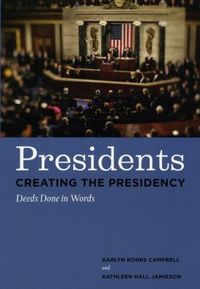

Purchase
Deeds Done in Words
University Of Chicago Press
May 2008
On Sale: May 1, 2008
384 pages
ISBN: 0226092216
EAN: 9780226092218
Hardcover
Add to Wish List
Non-Fiction
Arguing that “the presidency” is not defined by the
Constitution—which doesn’t use the term—but by what
presidents say and how they say it, Deeds Done in Words has
been the definitive book on presidential rhetoric for more
than a decade. In Presidents Creating the Presidency, Karlyn
Kohrs Campbell and Kathleen Hall Jamieson expand and recast
their classic work for the YouTube era, revealing how our
media-saturated age has transformed the ever-evolving
rhetorical strategies that presidents use to increase and
sustain the executive branch’s powers.
Identifying the primary genres of presidential
oratory, Campbell and Jamieson add new analyses of signing
statements and national eulogies to their explorations of
inaugural addresses, veto messages, and war rhetoric, among
other types. They explain that in some of these genres, such
as farewell addresses intended to leave an individual
legacy, the president acts alone; in others, such as State
of the Union speeches that urge a legislative agenda, the
executive solicits reaction from the other branches.
Updating their coverage through the current administration,
the authors contend that many of these rhetorical acts
extend over time: George W. Bush’s post-September 11
statements, for example, culminated in a speech at the
National Cathedral and became a touchstone for his
subsequent address to Congress.
For two centuries, presidential discourse has
both succeeded brilliantly and failed miserably at
satisfying the demands of audience, occasion, and
institution—and in the process, it has increased and
depleted political capital by enhancing presidential
authority or ceding it to the other branches. Illuminating
the reasons behind each outcome, Campbell and Jamieson draw
an authoritative picture of how presidents have used
rhetoric to shape the presidency—and how they continue to
re-create it.
Comments
No comments posted.
Registered users may leave comments.
Log in or register now!
| 


 © 2003-2024 off-the-edge.net
all rights reserved Privacy Policy
© 2003-2024 off-the-edge.net
all rights reserved Privacy Policy